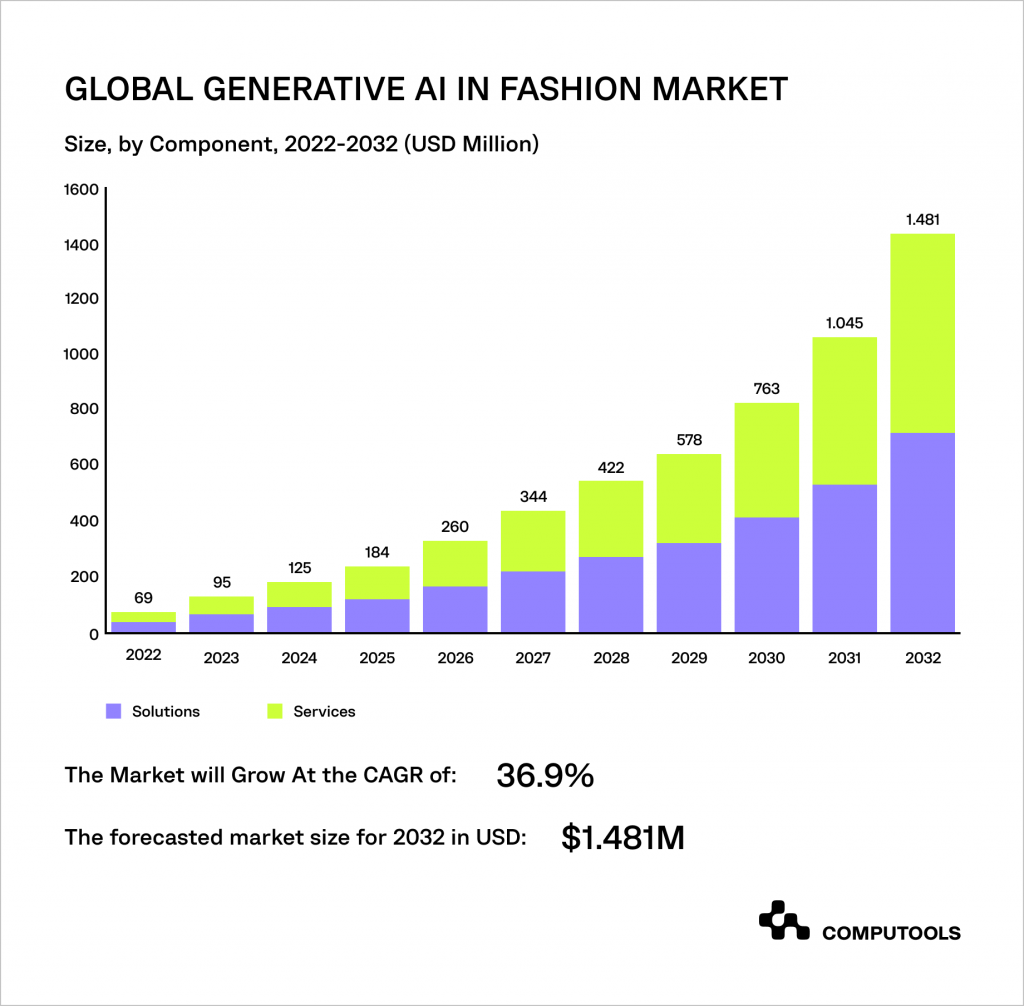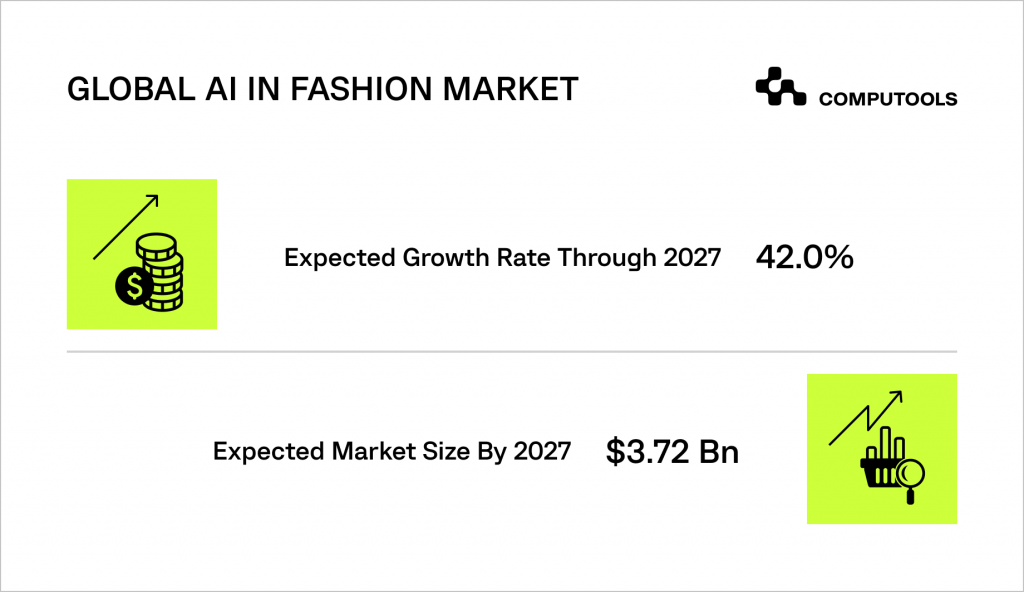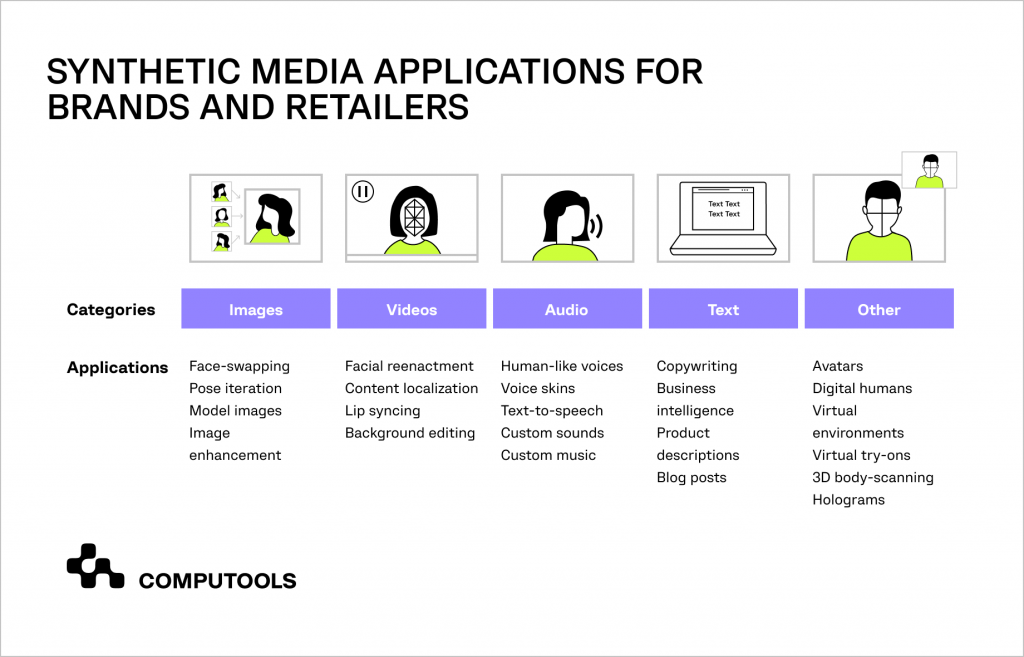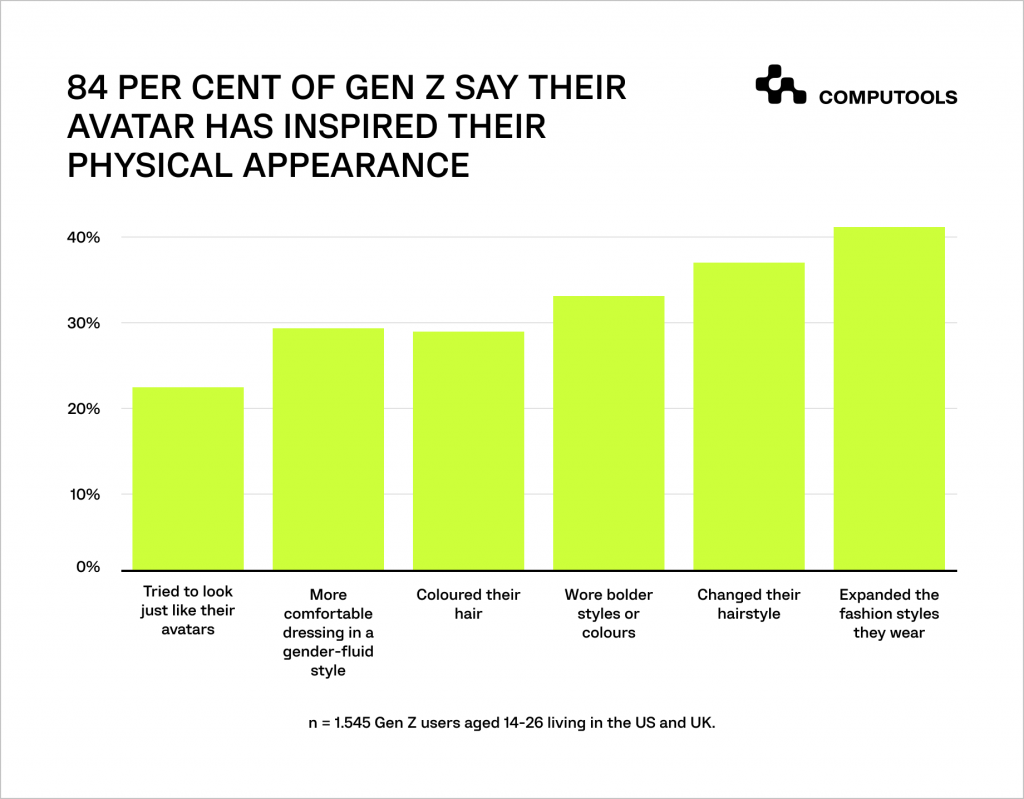Fashion is one of the world’s largest industries, profoundly influencing global economic dynamics and creating significant value worldwide.
The realm of fashion technology is on the brink of a major transformation. With innovations ranging from virtual reality-enhanced shopping experiences to the broad adoption of artificial intelligence, technology is reshaping our interaction with fashion in contemporary times.
Exploring the advancements that are altering our clothing, shopping behaviours and the narratives they weave, business owners have to pay attention to these changes. This article provides a glimpse into the future of fashion as we anticipate it.
Fashion Industry Market Overview
The fashion industry, with its immense scale, makes a significant contribution to the global economy, projected to reach US$670.90 billion in 2024, according to Statista.
Despite such growth, the industry’s operational landscape has seen minimal changes over the past two decades. However, recent trends indicate a period of transformation ahead.
A McKinsey report highlights the industry’s resilience, noting that economic profits in 2022 more than doubled those of the previous decade, excluding one outlier year.
Yet, the sector has begun to encounter growing challenges, prompting the exploration of new avenues for growth.
One such promising avenue for small businesses is social media marketing. In this competitive market, small businesses, including independent designers and boutique stores, remain at the forefront of innovation, sustainability and ethical practices.
Despite limited resources and fierce competition, over 77% of small businesses have reported increased customer engagement and sales through social media platforms like Instagram and Facebook, as stated by Forbes Advisor.
Medium-sized fashion companies have found their niche in promoting sustainability, capturing a significant market share by addressing the eco-friendly needs of customers.
According to the Fashion Accountability Report by ReMake, medium businesses achieved an average score of 37 points, surpassing the 9-point average of larger companies.
This outstanding performance positions medium-sized companies as the most sustainable brands, outperforming their larger competitors by a considerable margin.
At the other end of the spectrum, major players like Zara, Nike and Louis Vuitton maintain their stronghold in shaping worldwide fashion and technology trends.
These industry giants, responsible for a significant portion of the fashion sector’s global economic profits, are grappling with the challenges of adapting to market shifts.
Large companies are making substantial investments in generative AI to create fresh designs, offer style advice and streamline the design process.
Market Research Report predicts that generative AI in the fashion market will grow to US$1.481 million by 2032.

Latest Technology Trends in the Fashion Industry
1. Artificial Intelligence
Artificial intelligence (AI) is transforming fashion design with a range of innovations, from creating garments without traditional sewing patterns to offering personalised fittings and predicting trends.
According to the Business Research Company, the size of AI in the fashion market will grow from US$0.91 billion in 2023 to $3.72 billion in 2027 at a compound annual growth rate of 41.6%.
Designers now utilise machine learning and state-of-the-art technologies to create new styles more efficiently and quickly, as AI minimises the need for human involvement in the design process, improves the accuracy of image recognition and enhances the ability to predict consumer responses to specific items.
Advancements in AI not only streamline clothing production but also improve product quality and profitability.
Additionally, AI is changing the retail experience by introducing chatbots, interactive displays and other technological solutions to enhance customer service.

2. 3D printing
Fashion brands, both established and emerging, are increasingly turning to 3D printing technology to explore its potential for on-demand manufacturing.
This new fashion technology opens up avenues for greater customisation, environmental sustainability and creativity in fashion.
While production times may be longer, this innovation significantly reduces waste and requires less labour compared to traditional manufacturing methods.
Moreover, advancements in digital knitting within the realm of 3D printing are expanding the possibilities for personalised fashion.
Renowned Dutch designer Iris van Herpen has been at the forefront of 3D-printed fashion since 2010 and is known for her innovative and unconventional designs.
Her Crystallization collection, unveiled in the same year, featured the first-ever 3D-printed dress on the runway.
Made from white polyamide, the dress was designed to resemble a frozen water splash, capturing a moment in time.
3. Synthetic Media
With the progression of AI, the fashion industry is set to witness numerous innovative developments.
A key area of exploration for fashion brands is synthetic media, which involves the creation of content through algorithms that can analyse and learn from audio, video, images and text to produce lifelike media outputs.
The realm of synthetic fashion technology is vast, evolving and multifaceted, including:
• Virtual Influencers
Virtual influencers are digital personas that connect with audiences on social media platforms.
Despite their non-existence in the physical world, these celebrities garner massive followings due to their distinctive, AI-generated personalities, setting new trends and influencing fashion choices among their digital audiences.
• Synthetic Video
Merging traditional filmmaking with synthetic video techniques has birthed groundbreaking formats, such as deepfakes.
In fashion, this could transform how clothing and styles are presented, offering a futuristic way to visualise and market designs.
• Synthetic Audio
Text-to-speech and voice cloning technologies, which allow for the creation of unique digital voices, have become particularly valuable in the fashion realm.
Firms like Resemble.ai are at the forefront, providing services that generate digital avatars with cloned voices, potentially changing how brands interact with their audience.
• Synthetic Music
AI’s ability to produce synthetic music that echoes the complexity of human-made compositions offers endless possibilities for the fashion industry.
From creating immersive soundscapes for virtual runway shows to tailoring music for promotional content, AI-generated music supports brand identity and engagement without the limitations of copyright.

4. Blockchain
Blockchain is revolutionising technology trends in the fashion industry by fostering traceability and efficiency across global supply chains.
It connects various stakeholders, including designers, manufacturers, retailers and consumers, facilitating the direct and secure exchange of information, designs and transactional data.
This capability allows for the precise tracking and documentation of garments and accessories, leveraging technologies such as track and trace and advanced inventory management systems.
Blockchain’s introduction to the fashion industry significantly enhances the transparency of the supply chain, promoting greater ethical manufacturing practices.
By documenting each step a product takes from creation to consumer, blockchain technology helps prevent counterfeiting, ensuring that any product without the proper digital-physical linkage is easily identified as fake.
5. Virtual and Augmented Reality
Virtual reality is causing a stir in the fashion industry, allowing designers to create virtual showrooms and runway shows, offering a lifelike viewing experience of garments without the need for physical presence.
Moreover, designers are using this emerging technology in the fashion industry to develop virtual fitting rooms, allowing consumers to try on outfits virtually, eliminating the need to visit a physical store.
Similarly, augmented reality is gaining ground, overlaying digital images onto the real world to enrich the shopping experience.
It enables consumers to visualise how clothes would look on them or assist designers in creating virtual prototypes of their designs.
6. Live Streaming
Social media platforms are transforming how brands interact with potential customers, with estimates suggesting that social commerce sales will reach around US$8.5 trillion by 2030, as forecasted by Statista.
A significant portion of this growth will come from ‘live commerce,’ where brands directly sell to customers via live broadcasts on social media.
This trend, already popular in China, is expected to expand to Western markets.
Social media also serves as a potent tool for trend forecasting, enabling fashion retail brands like Shein to tap into large audiences by analysing influencer and designer posts to identify emerging trends.
7. Metaverse
With tightening data privacy regulations making traditional customer targeting strategies less effective and more costly, fashion retailers are exploring new avenues like the metaverse.
The metaverse, consisting of various virtual experiences and environments, provides users with spaces to play, socialise and shop.
While it remains uncertain if the metaverse will endure as a lasting fashion technology, major retailers are already heavily investing in these digital worlds to attract younger demographics.
Fast fashion brands like H&M have ventured into Gen Z-frequented virtual worlds like Roblox with initiatives allowing players to create and dress their avatars in virtual clothes.
Given that 84% of Roblox’s Gen Z players say their real-world fashion is influenced by their avatar’s outfits, as discovered by Vogue Business, this presents significant opportunities for brands willing to innovate and explore these virtual spaces.

The Rise of Custom Software Solutions
Today, custom software solutions have become a foundation for fashion brands, delivering a wide range of functionalities that cater to diverse aspects of the business.
Focusing on processes, these solutions enhance the brand’s capability to offer personalised product selections that appeal directly to specific customer segments.
Additionally, web development services streamline operations, such as inventory management and supply chain logistics, making sure that the business operates without disruption.
Regarding production, software tools enable brands to innovate and refine their product development strategies, facilitating a more dynamic and creative approach to bringing new designs to market.
Mobile app development helps connect fashion brands with their audience, providing a direct channel for engagement and sales.
As the fashion industry continues to expand on a global scale, the need for cohesive software development becomes even more critical.
Collaboration with a reliable IT partner who has profound subject matter expertise in the fashion industry is important for crafting scalable and secure infrastructure, reflecting the brand’s identity and growth strategy.
Computools delivers reliable working practices and solutions, validated through successful case studies with notable clients, including industry leaders like Dior.
Our software development company also highlights our technical expertise, evident in our practice of integrating contemporary trends into our work.
Anticipated Technological Advancements
Numerous prominent fashion retailers have closed their doors due to a lack of innovation, and more are expected to follow suit.
For businesses to survive, they must focus on sustainability and embrace technology trends in fashion, recognised as key opportunities within the industry. Here are some market predictions for upcoming years.
1. Generative AI
The year 2023 marked an important year for generative AI. To fully leverage this trend, stakeholders in the fashion industry need to look beyond simple automation.
They should investigate how AI can augment the creative efforts of humans, blending technology with creativity to push boundaries.
2. Brand marketing
As the fashion industry shifts focus away from performance-driven marketing, brand marketing is set to regain its central role. By building emotional connections with their audience, brands can benefit significantly.
Marketers are thus recalibrating their strategies to focus on long-term brand equity rather than immediate performance metrics.
3. Sustainability
Sustainability is becoming non-negotiable. The fashion industry’s era of self-regulation is coming to an end, with upcoming regulations in various jurisdictions poised to impact consumers and businesses alike.
Brands and manufacturers may find themselves needing to overhaul their business models to comply with these new standards.
Final Thoughts
Implementing these technology trends in the fashion industry might initially appear daunting or expensive, yet the long-term advantages they bring are indispensable.
They open up fresh avenues for companies and designers to move beyond conventional practices towards exploring innovative and captivating approaches.
Ready to embrace the future of fashion technology? Contact us via email at info@computools.com to learn how you can leverage these trends for your business.

Computools
Software Solutions
Computools is a digital consulting and software development company that delivers innovative solutions to help businesses unlock tomorrow.









“Computools was selected through an RFP process. They were shortlisted and selected from between 5 other suppliers. Computools has worked thoroughly and timely to solve all security issues and launch as agreed. Their expertise is impressive.”